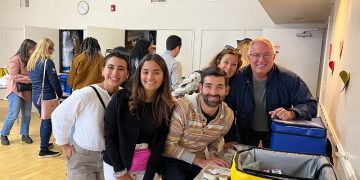Editor’s Note: This is an Op-Ed submission from Santa Monica Mayor Pro Tem Terry O’Day and Santa Monica councilwoman Gleam Davis.
This weekend many of you saw petitioners asking for a referendum on our City Council decision regarding the former Papermate factory, now owned by Hines.
Like many decisions affecting our future, it has generated a broad community discussion. In fact, the discussion about this site took place over eight years.
The council recently conferred the rights to redevelop the property, which is currently unoccupied. In this city, unoccupied buildings do not stay that way for long, so not developing the property is not the question before us.
The property is a large part of our eastside and Olympic corridor. Its 7 acres extend from Stewart to 26th Street along Olympic Boulevard.
A 206,000 square foot former factory occupies the land. Next time you have a chance, take a look at the size of this building and the way it bisects our neighborhoods and cuts off circulation.
The property is what planning experts call a “superblock.” Such blocks disrupt the normal grid of our streets, creating traffic as people circulate around them.
This one in particular has no sidewalks or pedestrian cut-throughs, making it particularly dangerous for bikes, pedestrians and children who travel around it. It has been abandoned for years, so although it disrupts our traffic, it does not generate any traffic of its own today and has not for some time.
Hines Company owns the property today, and without any approval from the City Council has the right to renovate the existing building, add to its size, and reoccupy with office space up to roughly 310,000 square feet.
For context, the Water Garden and Colorado Center offices in the neighborhood have over 2 million square feet. They would be required to make only the smallest of pedestrian improvements and few traffic control measures. The environmental studies we conducted on the site found that thousands of trips per day would be generated by reoccupation.
Our City Council and Planning Commission considered this situation and with the input of thousands of residents over eight years developed alternative plans for the area, referred to as the LUCE (Land Use and Circulation Element) and Bergamot Area Plan.
We negotiated for six years with the owners of the property to create something that would serve our community better and limit the traffic that would come from expanding and reoccupying the current building.
The result is still a large development. Any 7-acre site is bound to be. What would be added to the project is about 60,000 square feet of commercial space, almost 500 units of housing, including for seniors and disabled residents – roughly 20% affordable in total – and artist live-work lofts for this arts district. Our community has an imbalance of jobs and housing, which fuels the traffic problems in this area. Most everyone agrees that adding housing on this property is a wise decision.
In exchange for adding mostly housing, our negotiations produced important benefits in circulation and traffic control that we would not get in reoccupation.
First, the superblock is broken and the grid is restored. The property owner grants the rights for three new streets and a pedestrian path through the site plus 2 acres of open space. Imagine granting a portion of your property to the city for the public to pass through – this is no small concession in itself – but there is more.
Second, major additional traffic improvements are required for the site, totaling over $4.7 million, and connecting the property to our new light rail station, the Bergamot Arts Center, and office and housing to the north.
The City Council also negotiated the most stringent traffic caps in any project in the city’s history through a unique mechanism that has not been used anywhere else in the region to our knowledge. The property must have a transportation demand management program that limits the trips in-and-out of the site.
If it exceeds the projected trip volumes, it must pay a penalty to the city per excess trip. The result is 12% fewer peak-period outbound trips (the notorious afternoon weekdays on Olympic) from the whole project than the reoccupied site would produce.
The approved project is also 25% less square feet than allowed under our unanimously-approved general plan, and then there are more benefits.
The City Council negotiated $11 million for child care programs throughout the city, $3 million in public art, $1.4 million for a bike sharing program, and $2 million for parks, including one that buffers the Expo Line maintenance yard – an important improvement for the neighborhood.
Our City Council approved the project because the question before us is not whether to develop the site or not. Rather it is whether we want to add housing, break up the superblock and create safe, walkable streets next to the new train station versus reoccupy a giant building. The question before our City Council was clear to us: we voted for less traffic, improved pedestrian safety, housing, parks and open space, and child care funding.
But the petition before our community today sets up a starker question. Overturning the City Council decision would send a clear message to Hines – reoccupy and expand the existing building.
We fully support our community democratically weighing in on this significant change to our eastside, as we have over eight years of community meetings, studies, and commission and council deliberation.
A successful referendum, however, would unwind the negotiated benefits and bring us more traffic. That is now the question before us.
Mayor Pro Tem Terry O’Day
Councilmember Gleam Davis












